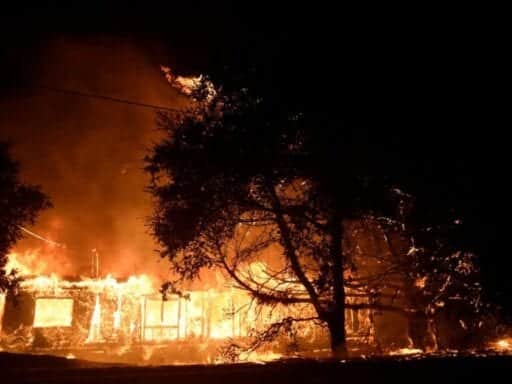New blazes have ignited and utilities are shutting off power to thousands to prevent another spark.
Wildfires once again ignited this week across California, with conditions for more severe blazes remaining high. Utilities are responding by shutting off power to their customers, with blackouts in many parts of California likely to extend through the weekend.
PG&E is monitoring weather conditions for a potential Public Safety Power Shutoff (#PSPS) within the next 18-36 hours. PG&E has sent phone, email and text notifications to customers who have provided PG&E with contact info. Check your address here: https://t.co/AUFB81ZXtQ pic.twitter.com/5NYuUIY5di
— PG&E (@PGE4Me) October 25, 2019
The National Weather Service warned Friday that “extreme fire behavior” was possible in the southern part of the state and that “extreme fire weather conditions are likely” in the interior of Northern California through the weekend.
A #RedFlagWarning has been issued for most of Northern CA & portions of Southern CA from today until late Thursday evening & even into Friday for some areas, due to strong winds & low humidity. This is #CriticalFireWeather exercise caution when outdoors. https://t.co/t4JLHQw4Vy pic.twitter.com/1niJbP4P6s
— CAL FIRE (@CAL_FIRE) October 23, 2019
The largest blaze is the Kincaid Fire in Sonoma County, which has burned through more than 21,900 acres so far and is only 5 percent contained. It’s raging in a sparsely populated region, where 49 homes have been destroyed and 2,000 people were forced to flee.
Meanwhile, the Tick Fire in Santa Clarita torched 4,300 acres, forced 50,000 residents to evacuate, and forced schools to close due to air quality concerns.
Fire officials also reported that the Saddleridge Fire near Los Angeles, which ignited two weeks ago, is 97 percent contained after burning 8,799 acres. (The California Department of Forestry and Fire Protection has a map of many of the current major fires throughout the state.)
Though 2019 has been a much less active fire year for California compared to the record-breaking fire seasons of 2017 and 2018, the risk for a severe fire remains high due to recent weather and long-term trends.
Seasonal winds — the Diablo winds of northern California and Santa Ana winds in the southern part of the state — are picking up strength this week with gusts up to 65 mph, helping blazes to spread. The weather in California this week has been hot and dry, with humidity below 9 percent in much of the state.
There is also plenty of vegetation ready to burn because a wet winter and spring this year caused a bumper crop of grasses and shrubs, followed by an extremely hot summer that led these plants to dry out.
It’s important to remember that wildfires are a natural part of many ecosystems in California, restoring nutrients to soils, regulating growth in forests, and even helping some plants germinate.
But the drivers of the growing fire risk in California are due to human-caused factors, some of which have been mounting for decades.
For one thing, Californians have built homes in fire-prone regions as the state’s housing crunch forced people away from major cities. This raises the likelihood of sparking a fire — about 84 percent of wildfires are now ignited by humans — and increases the ensuing damage with so much more property in harm’s way.
Reports indicate that the Kincaid Fire started in The Geysers, the largest geothermal electricity facility in the world. A transmission line operated by Pacific Gas and Electric reported problems shortly before the fire began and firefighters found power equipment that was not shut off even though the utility was deliberately cutting off power to some areas to reduce the risk of igniting a fire.
Years of suppressing natural fires has paradoxically allowed vegetation to build up to unnatural levels. That means that when a fire does occur, it can burn with greater speed, range, and intensity.
People are also causing climate change. That has contributed to Western forests drying out as average temperatures rise. It has also exacerbated the impacts of California’s years-long drought. These stresses have left trees vulnerable to pests like bark beetle. Together, these factors have led to the deaths of 149 million trees in California. Hotter, drier conditions over the long term will only worsen the fire risk.
Californians are taking steps to reduce these fire risks, but the challenge is immense and some of the tactics have proved controversial. This week, the US Forest Service began a controlled burn in Butte County, the site of 2018’s Camp Fire, the state’s deadliest and most destructive wildfire. But the Camp Fire burned more than 150,000 acres. The controlled burn is only over 300 acres, which means there’s still a lot more wilderness area that may need this treatment.
PG&E, the utility serving northern California that was found liable for starting several major fires, has undertaken another round of Public Safety Power Shutoffs — deliberate blackouts — to reduce fire risk. The utility has warned that these shutoff could last for days.
Southern California Edison, which provides power to the southern part of the state, has already shut off power to more than 20,000 customers; the number could rise to 300,000 customers over the weekend. Beyond the potential for billions of dollars in economic losses to the state, many of the most vulnerable, like people who rely on home medical equipment, stand again to be hit the hardest by the blackout.
Vox’s David Roberts has explained at length that factors that led these utilities to undertake such a drastic action and why California is likely to experience these shutoffs again. It will take years for better land management practices, new housing policies, and upgrading power infrastructure to reduce the overall fire risk. In the meantime, California faces the prospect of more fires or even more drastic actions to prevent them.
Author: Umair Irfan
Read More



